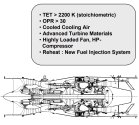You are using an out of date browser. It may not display this or other websites correctly.
You should upgrade or use an alternative browser.
You should upgrade or use an alternative browser.
Chinese Engine Development
- Thread starter jackbh
- Start date
According to Yankeesama, the thrust of WS-19 is 1.x tons smaller than the Su-27's engine (didn't mention any specific model).
It's in "Cha Hua Hui", 28:20, April 24th.
That’s unexpected. Thought it is in same ballpark as EJ-200?
He didn't mention that. But he did say that WS-21 used WS-19's tech for upgrade and you cant simply say that the thrust of WS-21 is equivalent to that of RD-33MK.That’s unexpected. Thought it is in same ballpark as EJ-200?
Last edited:
That’s unexpected. Thought it is in same ballpark as EJ-200?
Well it's pretty easy to estimate a worst case scenario and see if it's expected or not.
Su-27's least capable engine is the vanilla Al-31, 7.8 tons dry, 12.5 tons wet
"1.x tons" less thrust than Su-27's weakest engine (Al-31), depending on what "1.x" means -- if we assume it again to be the worst case scenario, would be let's say 1.9 tons
So if we're going by dry thrust and wet thrust respectively, just minus 1.9 tons from 7.8 and 12.5 respectively (if they scale that way), i.e.: worst case/lowest end estimate of WS-19 thrust is 5.9 tons thrust dry and 10.6 tons thrust wet. In kN that is 58kN dry and 104kN wet (the differences probably don't scale like that, so let's just take the 58kN number as the important one).
If we're going by Rolls Royce, EJ200 is 60kN dry and 89kN wet.
F414, of a similar engine class is 58kN dry, 98kN wet
So, based on Yankee's description, going from the "lowest estimate," the WS-19's thrust characteristics would be basically what we'd expect for a EJ200/F414 class engine. Now, if the "1.x" isn't 1.9 and say, 1.5 or 1.3 or lower, then the thrust of the engine would be even more capable.
I think you misheard. Yankee said that the empty weight of the J-35A is 1 ton less than the Su-27, indicating that it is basically a heavy weight twin engine jet. In the same segment, he explained that J-35A's size and superior material science and design is what enabled its long, F-35-beating range despite two engines.According to Yankeesama, the thrust of WS-19 is 1.x tons smaller than the Su-27's engine (didn't mention any specific model).
It's in "Cha Hua Hui", 28:20, April 24th.
Well, he was talking about internal fuel.I think you misheard. Yankee said that the empty weight of the J-35A is 1 ton less than the Su-27, indicating that it is basically a heavy weight twin engine jet. In the same segment, he explained that J-35A's size and superior material science and design is what enabled its long, F-35-beating range despite two engines.
Last edited:
I've been telling y'all. Potentially (and quite likely too) up to 127 kN wet. If you want to be very conservative, 118 kN. Even at absolutely worst it would be 100+ kN like Blitzo said (but the first two figures are a specific range I was given, I wouldn't really expect it to be under 12,000 kgf).According to Yankeesama, the thrust of WS-19 is 1.x tons smaller than the Su-27's engine (didn't mention any specific model).
It's in "Cha Hua Hui", 28:20, April 24th.
The engine architecture apparently takes after a philosophy similar to that of the EJ200 family. The family includes (admittedly unbuilt, but incredible) variants like EJ220 at 103 kN and the EJ270 at 120 kN. The WS-19 itself is probably closer to the EJ270 than the vanilla EJ200 instead.That’s unexpected. Thought it is in same ballpark as EJ-200?

Yup. IIRC it's mainly the hot section components, especially the combustor and augmentor.He didn't mention that. But he did say that WS-21 used WS-19's tech for upgrade and you cant simply say that the thrust of WS-21 is equivalent to that of RD-33MK.
However, the WS-19 will most likely used "fully realised" iterations of said technologies that were designed with other components in the first place, i.e. they'll work better than in the WS-21, and there's other shiny tech in the WS-19.
The EJ270 and the F414-EPE already showed that it is possible in theory.That would be at least at the F100-PW-200/220 level thrust in a much smaller package.
IIRC he's talking about internal fuel volume, not weight.I think you misheard. Yankee said that the empty weight of the J-35A is 1 ton less than the Su-27, indicating that it is basically a heavy weight twin engine jet. In the same segment, he explained that J-35A's size and superior material science and design is what enabled its long, F-35-beating range despite two engines.
You're right. I mistook that for thrust.IIRC he's talking about internal fuel volume, not weight.
But he did mention that WS-19 is close to, so called, "大推".
So what's the verdict for us non-Chinese speakers?You're right. I mistook that for thrust.
But he did mention that WS-19 is close to, so called, "大推".
